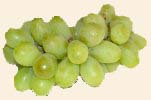|
Bioflavonoids
- Bioflavonoids are a group of plant polyphenolic compounds that exhibit remarkable health promoting benefits
although the mechanisms by which these benefits are brought about remain largely unknown.
A well studied group is the quercetin-based flavonoids such as the citrus flavonoids rutin,
quercetin and hesperetin.
Another class of biologically acitve flavonoids is that of the proanthocyanidins, which are usually present as
oligomers (OPC).

The structure of three well known flavonoids.
- OPC are the most powerful antioxidants, being 20 times and 50 times more so
than vitamin C and vitamin E, respectively. However, these findings from test tube experiments may have little relevance to the process in vivo. In fact, there is growing evidence to suggest that flavonoids undergo extensive transformation in vivo, which results in a significant alteration of their redox potentials. Many flavonoids, which occur as glycosides in plants are deglycosylated in the body then conjugated with monosaccharides, sulfur compounds or O-methylated. Flavonoids can also be degraded by the colon bacteria to simple phenols that are absorbed and further metabolized in the liver. The antioxidant function
relies on the two OH groups in the B ring and /or the double bond and the OH group in the C ring. The catechol group in the B ring can also chelate metal ions thus removing one of the reactants in the metal-catalyzed reactive oxygen species generation reactions (1, 2). The concentration of flavonoid metabolites in blood plasma and several other tissues is much lower than that of ascorbate and
a-tocopherol. It appears unlikely that flavonoids can exert their beneficial action only by virtue of their antioxidant function. It is interesting to note that flavonoids were found to protect neurons against oxidative stress more effectively than the ascorbic acid even when this was used at a concentration10-fold higher than that of the flavonoids. This led to the conclusion that flavonoids may act through a mechanism other than based on antioxidant activity (3).
Flavonoids may act as modulators of cellular events through specific interaction with key proteins in the intracellular signalling cascade. One such pathway is the mitogen-activated
protein kinase (the so-called MAP kinase) signaling pathway. By interacting with proteins such as phosphoinositide 3-kinase, tyrosine kinase, MAP kinase flavonoids or their metabolites can exert stimulatory or inhibitory actions, which are likely to influence the phosphorylation state of target proteins or to modulate gene expression. Flavonoids have been shown to interact with subcellular organelles such as mitochondria and to interfere with biochemical pathways of intermediate metabolism or downregulate the expression of adhesion molecules (4). For more information on this exciting field of research go to this excellent recent review article (5).
- OPC potentiate the action of vitamin C, which is essential for collagen synthesis. As a result, arteries and veins are strengthened because of increased collagen stability (collagen is the main protein in the wall of blood vessels).
- OPC inhibit the formation of nitrosamines (cancer-causing agents) from food additives
and other environmental pollutants, such as pesticides and herbicides, car exhaust fumes,
cigarette smoke, industrial emissions, etc. OPC exhibit significant antiviral activity against herpes
virus type I, influenza virus, syncytial virus and others although the mechanism by which this is achieved is not clear at present.
- Health benefits: The scavenging of free radicals reduces the risk of: cardiovascular disease, cancer, allergic reactions, autoimmune disorders (rheumatoid arthritis, lupus), degenerative diseases (Alzheimer's disease, Parkinson's disease, multiple sclerosis). OPC improve brain function, enhance the immune response, reduce diabetes symptoms, etc. Here again we must stress that when reference is
made to the health benefits of flavonoids/OPC supplementation in fighting/prevention of cancer, proliferative disorders, chronic inflammation and neurodegeneration one should bear in mind the complex interactions of flavonoids or their derivatives with the various signaling and metabolic pathways as a means of cellular response to injury whether by internal or external factors and less about the flavonoids exerting their biological action mainly as free radical scavengers as often portrayed in the popular science publications.
In promoting the nutraceuticals industry's marketing executives are quick to exploit any data on the antioxidant activity of OPC/flavonoids (mainly from in vitro experiments) published in science journals, that may further their sales efforts. So, until solid information is acquired on the mechanisms by which bioflavonoids exert their biological action and the potential clinical benefits of flavonoids intake (coming from large scale double blind-controlled epidemiologic studies) caution should be exercised when taking OPC-based nutritional supplements.
- Best food sources: grapes (seeds), citrus fruits, berries, onions, parsley, apples, pears, apricots, cabbage, tomatoes, green tea.

References
1. Rice-Evans, C. (2001) Curr.Med.Chem. 8, 797-807. Flavonoids antioxidants.
2. Rice-Evans, C. et al. (1996) Free Rad.Biol.Med. 20, 933-956. Structure-antioxidant activity relationships
of flavonoids and phenolic acids.
3. Schroeter, H. et al. (2000) Free Rad.Biol.Med. 29, 1222-1233. Phenolic antioxidants attenuate neuronal cell
death following uptake of oxidized low density
lipoprotein.
4. Gerritsen, M.E. et al. (1995) Amer.J.Pathol. 147, 278-292. Flavonoids inhibit cytokine-induced endothelial
cell adhesion protein gene expression.
5. Williams, R.J. et al. (2004) Free Rad.Biol.Med. 36(7) 838-849. Flavonoids: Antioxidants or signalling molecules?
|

